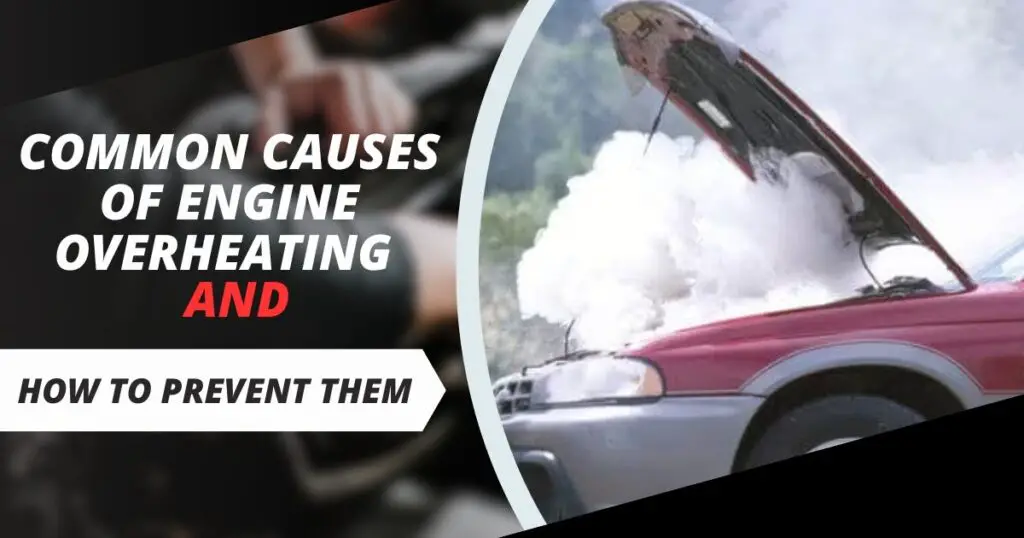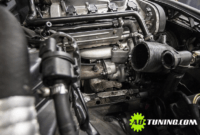6 Common Causes of Engine Overheating and How to Fix Them is a vital topic for every car owner. Understanding the reasons behind engine overheating can help you prevent costly repairs and ensure your vehicle runs smoothly. With engines being the heart of our vehicles, keeping them at optimal temperatures is essential for longevity and performance. Common causes of overheating include low coolant levels, malfunctioning thermostats, and broken water pumps, among others.
By recognizing the signs early and addressing them promptly, you can maintain your engine’s health and enhance your driving experience.
Introduction to Engine Overheating: 6 Common Causes Of Engine Overheating And How To Fix Them
Monitoring engine temperature is crucial for maintaining vehicle health and performance. An engine operating beyond its optimal temperature can lead to significant damage, costly repairs, and even complete engine failure. By keeping an eye on the engine’s temperature gauge, drivers can identify potential overheating issues before they escalate into serious problems.Common causes of engine overheating include coolant leaks, faulty thermostats, and blocked radiators.
Each of these factors can impair the engine’s ability to dissipate heat effectively. According to the American Automobile Association (AAA), engine overheating is a leading cause of roadside breakdowns, emphasizing the necessity of preventive maintenance. In fact, studies show that approximately 20% of vehicles experience engine overheating at some point, highlighting the importance of understanding its causes and solutions.
Significance of Monitoring Engine Temperature
Regularly checking the engine temperature can prevent overheating-related issues that lead to drastic consequences. Drivers should be aware of the following key aspects:
- Early Detection of Problems: Monitoring temperature allows for early identification of cooling system malfunctions, enabling timely repairs.
- Enhanced Vehicle Longevity: Keeping the engine at optimal temperatures prolongs its lifespan, reducing the likelihood of expensive repairs.
- Improved Fuel Efficiency: An engine running at the correct temperature operates more efficiently, contributing to better fuel economy.
- Safety and Reliability: An overheated engine can lead to dangerous situations, including engine fires. Regular monitoring ensures a safer driving experience.
In summary, maintaining a vigilant eye on engine temperature is not merely a good practice; it is essential for the overall performance, efficiency, and safety of any vehicle. Addressing overheating issues is vital to avoid catastrophic engine failures and ensure a smooth driving experience.
Low Coolant Levels
Coolant plays an essential role in maintaining the optimal temperature of an engine, enabling it to operate efficiently without overheating. It circulates through the engine and radiator, absorbing heat and dissipating it away from critical components. When coolant levels drop, the engine is deprived of the necessary fluid to regulate temperature, leading to potential overheating issues.Low coolant levels can manifest through several noticeable symptoms that indicate a need for immediate attention.
Common signs include the engine temperature gauge reading higher than normal, the presence of steam rising from the engine bay, and the illumination of the temperature warning light on the dashboard. Additionally, drivers may notice coolant leaks under the vehicle or a sweet smell that indicates a coolant leak inside the cabin.To ensure coolant levels are adequate, it is essential to periodically check and refill them as necessary.
Begin by locating the coolant reservoir, typically a translucent plastic tank situated near the radiator. Ensure the engine is cool before opening the reservoir cap to prevent burns from hot coolant or steam. The coolant level should be between the minimum and maximum markings on the tank. If levels are low, use a 50/50 mix of antifreeze and distilled water for refilling, as this combination provides optimal protection against freezing and boiling.
Always inspect for leaks around hoses and connection points, and replace any damaged components to avoid future coolant loss.
Regular maintenance of coolant levels is crucial for engine longevity and performance.
Malfunctioning Thermostat

The thermostat plays a crucial role in maintaining the engine’s optimal temperature. It ensures that the engine receives the right amount of coolant, preventing overheating or excessive cooling. A malfunctioning thermostat can disrupt this balance, leading to various engine problems.The thermostat is designed to regulate coolant flow based on the engine temperature. When the engine is cold, the thermostat remains closed, preventing coolant from circulating.
As the engine heats up, the thermostat opens, allowing coolant to flow and maintain a steady temperature.
Signs of a Faulty Thermostat
Identifying a malfunctioning thermostat is essential for preventing serious engine damage. Here are the common signs that indicate a faulty thermostat:
- Engine Overheating: If the engine temperature gauge consistently reads high, it may indicate that the thermostat is stuck closed.
- Coolant Leaks: A malfunctioning thermostat can lead to coolant leaks around the thermostat housing.
- Unexpected Temperature Fluctuations: Rapid changes in temperature readings while driving can signal a thermostat issue.
- Poor Heating Performance: Inconsistent cabin heat during cold weather might suggest that the thermostat is stuck in an open position.
Testing and Replacing a Faulty Thermostat
Testing the thermostat is a straightforward process that can help determine whether it needs replacement. First, ensure the engine is cool. Remove the thermostat from the engine and place it in a pot of water on the stove. Gradually heat the water while observing the thermostat. It should open at its rated temperature.
If it does not, it’s time for a replacement.When replacing a faulty thermostat, follow these steps to ensure proper installation:
- Gather necessary tools: socket wrench, new thermostat, gasket, and gasket sealant.
- Drain the coolant from the radiator to prevent spills.
- Remove the old thermostat and gasket from the housing.
- Clean the surfaces to ensure a proper seal.
- Install the new thermostat and gasket, applying gasket sealant if recommended.
- Reattach the housing and refill the cooling system with coolant.
“A properly functioning thermostat is essential for maintaining engine temperature; neglecting it can lead to severe engine damage.”
Broken Water Pump
The water pump plays a crucial role in the vehicle’s cooling system, ensuring that coolant circulates efficiently throughout the engine and radiator. When the water pump malfunctions or breaks, it can lead to severe engine overheating, potentially causing significant damage if not addressed promptly. Understanding the importance of the water pump, along with the signs of its failure and the steps for inspection and replacement, is essential for maintaining engine health.The water pump is responsible for circulating coolant within the cooling system, allowing the engine to maintain a safe operating temperature.
A properly functioning water pump helps prevent overheating, which can cause catastrophic engine damage. If the water pump becomes defective, it can lead to inadequate coolant flow, resulting in overheating and a decrease in overall engine performance. Symptoms of a failing water pump include unusual noises, coolant leaks, and an overheating engine. Recognizing these signs early can save time and money on repairs.
Symptoms of a Failing Water Pump
There are several indicators that suggest your water pump may be malfunctioning. Identifying these symptoms early can help prevent more severe engine damage. The following symptoms often accompany a failing water pump:
- Unusual Noises: A whining or grinding noise from the engine compartment could indicate a failing water pump bearing.
- Coolant Leaks: Puddles of coolant under the vehicle or visible coolant on the engine may suggest a leak from the water pump seal or housing.
- Overheating Engine: If the engine temperature gauge rises above normal levels, this could be a sign of inadequate coolant circulation.
- Corroded or Rusty Water Pump: Visible corrosion or rust on the water pump can indicate a compromised unit that needs immediate attention.
Inspection and Replacement of a Broken Water Pump
Inspecting and replacing a broken water pump is a vital maintenance task. Here is a step-by-step guide for performing this procedure effectively:
1. Prepare the Vehicle
Ensure the engine is cool and the vehicle is parked on a flat surface.
Disconnect the negative battery terminal to prevent electrical issues during the process.
2. Drain the Coolant Locate the radiator drain plug and place a container underneath to catch the coolant. Open the drain plug and allow the coolant to empty completely.
3. Remove the Drive Belt Identify the drive belt that powers the water pump. Use a wrench to release tension and remove the belt from the water pump pulley.
4. Disconnect the Water Pump Remove any hoses connected to the water pump. Take care to note their positions for reinstallation. Remove the bolts securing the water pump to the engine. Keep track of bolt locations for reassembly.
5. Inspect the Water Pump Examine the old water pump for wear, leaks, or damage. Check the gasket surface for any residue that may need cleaning.
6. Install the New Water Pump
Place a new gasket on the mount surface, ensuring proper alignment.
Position the new water pump, securing it with the bolts removed earlier. Tighten them according to manufacturer specifications.
7. Reconnect Hoses and Drive Belt
Reattach all hoses to the water pump, ensuring they are secure.
Reinstall the drive belt, ensuring it is properly aligned on all pulleys.
8. Refill the Coolant
Close the radiator drain plug and refill the cooling system with the appropriate coolant mixture.
Start the engine and let it run, checking for leaks and proper operation of the water pump.
9. Test the System Monitor the engine temperature and ensure that the coolant circulates properly. Verify that the water pump is functioning without any unusual noises.
Clogged Radiator
A clogged radiator can significantly hinder your vehicle’s ability to maintain optimal engine temperatures. As the radiator plays a crucial role in dissipating heat generated by the engine, any obstruction can lead to overheating issues, which may result in costly repairs or engine damage.A clogged radiator affects engine cooling by restricting the flow of coolant through the system. When the coolant cannot circulate freely, it fails to absorb and dissipate heat effectively, leading to increased engine temperatures.
This can trigger the engine overheating warning light and may cause the engine to shut down to prevent further damage.
Common Causes of Radiator Clogs
Several factors contribute to the accumulation of debris and blockages within the radiator. Understanding these causes can help in preventing future issues. Key contributors include:
- Corrosion: Over time, internal corrosion from rust and scaling can build up and obstruct coolant flow.
- Debris: Dirt, leaves, and other contaminants can enter the radiator, leading to clogs.
- Old Coolant: Using coolant that has not been changed according to manufacturer recommendations can lead to sludge formation, which clogs the radiator.
- Fouling: Debris from engine wear and tear, such as metal shavings, can accumulate in the radiator.
Flushing and Cleaning the Radiator
Regular maintenance is essential for keeping the radiator in good working order. Flushing and cleaning the radiator helps restore its functionality. The following methods can be employed:
- Radiator Flush: Using a commercial radiator flush product can help remove built-up debris and sludge. This is typically done by draining the old coolant, adding the flush product, running the engine for a specified period, and then flushing it out with water.
- Manual Cleaning: In some cases, disassembling the radiator for a thorough cleaning with brushes and solvents may be necessary. This is often recommended for severe clogs.
- Professional Servicing: Seeking help from a professional mechanic can ensure that the radiator is cleaned and flushed properly, using specialized equipment.
- Routine Inspections: Regular checks for leaks or signs of corrosion can help catch issues before they lead to clogging.
Maintaining your radiator’s cleanliness is crucial; neglect can lead to overheating and severe engine damage.
Faulty Cooling Fans
Cooling fans play a pivotal role in regulating engine temperature, ensuring optimal performance and preventing overheating. They work in conjunction with the radiator to dissipate heat generated during engine operation. When these fans malfunction, the engine can quickly reach dangerous temperatures, leading to severe damage if not addressed promptly.Cooling fans are designed to activate when the engine reaches a certain temperature, pulling air through the radiator to cool the coolant before it returns to the engine.
Signs of malfunctioning cooling fans can manifest in various ways, and recognizing these early can save you from costly repairs.
Signs of Malfunctioning Cooling Fans
Identifying issues with cooling fans can be crucial for maintaining engine health. Here are key indicators that your cooling fans may be faulty:
- Engine overheating during idling or slow speeds indicates that the fans may not be engaging as needed.
- Unusual noises such as grinding or a high-pitched whirring sound can suggest that the fan motor or blades are damaged.
- The fans not operating at all, which can be confirmed by visual inspection while the engine is running and temperature rises.
- Inconsistent temperature readings on the dashboard gauge, indicating that cooling is not functioning properly.
Troubleshooting and Replacing Faulty Cooling Fans
Diagnosing and fixing cooling fan issues involves several systematic steps to ensure proper functionality. Understanding these steps can help you determine whether to repair or replace the fans.Start by checking the electrical connections and fuses associated with the cooling fan system. A blown fuse or loose wiring can prevent the fans from receiving power. If the connections are secure and the fuses are intact, the next step is to test the fan motor itself.
This can often be done using a multimeter to check for voltage at the motor terminals.If the motor is receiving power but not functioning, it may need to be replaced. For the replacement process, follow these detailed steps:
1. Disconnect the Battery Ensure safety by disconnecting the negative terminal of the battery before starting any repairs.
2. Remove the Fan Assembly Depending on your vehicle model, this may involve removing screws or bolts to detach the fan from its housing.
3. Install the New Fan Position the new fan into the assembly, securing it in place with the appropriate fasteners.
4. Reconnect Electrical Connections Ensure all wiring is properly connected, and double-check for any loose or damaged wires.
5. Test the System Reconnect the battery and start the engine, allowing it to reach operating temperature to verify that the fans engage as expected.In maintaining your vehicle, keeping a keen eye on the cooling fans can prevent overheating and prolong engine life. Regular inspections and timely repairs are key aspects of proactive vehicle maintenance.
Other Potential Causes
Engine overheating can stem from various factors beyond the commonly recognized issues. Often, underlying problems like leaking hoses or issues with the exhaust system can contribute significantly to an engine’s temperature rising. Understanding these less common causes can help in preventing serious damage and ensuring your vehicle operates efficiently.Leaking hoses can disrupt the flow of coolant, leading to inadequate cooling of the engine.
Additionally, problems with the exhaust system, such as a blocked or damaged exhaust, can increase engine temperature due to the additional strain placed on the engine to expel exhaust gases. Recognizing these potential culprits is essential for effective engine maintenance.
Diagnosing Less Common Causes
When diagnosing potential causes of engine overheating that may not be immediately apparent, it’s beneficial to have a structured checklist. This helps pinpoint issues that often go overlooked.
- Inspect for visible leaks in hoses and connections.
- Examine the exhaust system for blockages or damage.
- Check for kinks or cracks in the coolant hoses.
- Monitor engine performance for signs of excessive strain, such as loss of power.
- Review the condition of the engine oil for contamination or depletion.
Regular preventive maintenance is crucial to avoid these issues. A proactive approach can save time and money while ensuring the longevity of your vehicle’s engine. Here are some tips to help maintain optimal engine temperature:
Preventive Maintenance Tips
Implementing regular checks and maintenance practices can significantly reduce the risk of overheating caused by less common issues. Consider the following strategies:
- Regularly inspect hoses for wear and replace them as necessary.
- Conduct routine exhaust system checks to identify any blockages or damage early.
- Flush the cooling system periodically to remove any debris or buildup.
- Ensure that all clamps and connections are secure to prevent leaks.
- Keep an eye on engine oil levels and quality, replacing it according to the manufacturer’s recommendations.
By integrating these preventive measures into your vehicle maintenance routine, you can avoid a host of problems that contribute to engine overheating, ultimately keeping your engine healthy and efficient.
Preventive Measures
Preventing engine overheating is both a crucial and manageable task for vehicle owners. By adopting a regular maintenance schedule and being vigilant about the condition of your vehicle, you can significantly reduce the risk of overheating incidents. This proactive approach not only enhances vehicle performance but also extends the lifespan of your engine.Routine maintenance plays a pivotal role in ensuring that all components of the cooling system are functioning optimally.
Regular check-ups help identify potential issues before they escalate into severe problems. Moreover, timely fluid changes are essential to maintain the effectiveness of your cooling system.
Regular Maintenance Schedule
Establishing a regular maintenance schedule is key to preventing engine overheating. This schedule should include:
- Monthly checks of coolant levels to ensure they are within the recommended range.
- Annual inspections of the thermostat, water pump, and radiator to detect any malfunctions.
- Routine flush and replacement of coolant every two years to maintain optimal performance.
- Regular replacement of engine oil, as this contributes to overall engine health.
Regular maintenance not only helps in identifying issues early but also ensures that all components are functioning as intended, thereby preventing unexpected overheating.
Importance of Routine Check-Ups and Fluid Changes
Routine check-ups and fluid changes contribute significantly to engine longevity and efficiency. When fluids are dirty or depleted, they can lead to increased friction and overheating. The following points highlight the importance of these practices:
- Check coolant levels regularly to prevent low coolant scenarios, which directly contribute to overheating.
- Inspect all hoses and belts for wear and tear, as they play a crucial role in the cooling system’s performance.
- Change engine oil and coolant as per the manufacturer’s recommendations to ensure peak performance.
- Address any leaks promptly to prevent a loss of critical fluids.
By prioritizing fluid changes and check-ups, vehicle owners can maintain the cooling system’s efficiency and prevent overheating incidents.
Monitoring Engine Temperature, 6 Common Causes of Engine Overheating and How to Fix Them
Monitoring engine temperature during operation is another essential preventive measure. Keeping an eye on the temperature gauge can serve as an early warning system for potential overheating. Consider the following tips to effectively monitor engine temperature:
- Familiarize yourself with your vehicle’s normal operating temperature range, usually indicated in the owner’s manual.
- Pay attention to any unusual fluctuations in temperature readings, which may signal emerging issues.
- Use an OBD-II scanner to check for any diagnostic trouble codes related to the cooling system.
- Be mindful of warning lights on the dashboard; they often indicate overheating or cooling system problems.
By actively monitoring engine temperature, drivers can take timely action to prevent damage caused by overheating, thereby ensuring a smoother driving experience.
Outcome Summary
In summary, knowing the 6 Common Causes of Engine Overheating and How to Fix Them empowers you to take proactive steps in vehicle maintenance. Regularly checking coolant levels, ensuring your thermostat functions correctly, and maintaining your radiator and water pump can significantly reduce the risk of overheating. By staying informed and vigilant about your engine’s health, you not only improve your car’s performance but also extend its life.
Keep these tips in mind, and you’ll be well on your way to a trouble-free driving experience.


